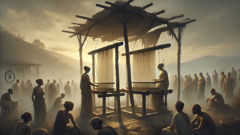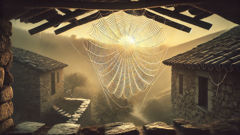Introduction
On the sun-warmed slopes above a sleeping valley of olive groves and tilled terraces, Arachne worked with a concentration that made the air around her seem to hum. The threads she drew across her loom held the quiet history of her village—spun wool, strips of dyed linen, and the faint streaks of sky found in the blue wools traded at the market. She wove without ceremony or haste, as if each shuttle stroke were a sentence and each knot a breath. Word of her skill threaded outward faster than the scent of baking bread; neighbors crossed fields to see how she could bend warp and weft into scenes that breathed. They said her fingers moved too fast to be merely human, that the eyes in her tapestries watched you from the walls. Arachne listened to praise and let it pool like a bright river inside her chest. Pride is a slow companion, subtle as a dye soaking cloth, and it settled there in patterns only she could see.
She was not born under a loom. Her mother had taught her to spin when she was small—just enough to ready a skein for mending—and her father, a humble dyer who died while she was yet young, had shown her how colors listened to one another when mixed. Alone with the loom after both parents were gone, she learned every secret the threads were willing to teach: how tension could sing, how a slight slack could ruin a face, how a single silver thread could make a river appear alive. As seasons turned she wove stories that townsfolk once told by mouth; scenes of harvest and of lovers, of traders passing through dust and rain, of gods walking among men and of the petty cruelties that passed for fate. In time the stories she put on fabric looked less like cloth and more like truth.
Among the people who came to see her work were elders who remembered the temples’ stone-carved myths as if they were family portraits. They would stand in her small house, sun slanting across a half-made tapestry, and whisper that she rivaled the gods in craft. The whisper reached a busy place: Athens, the city of wisdom and woven olive wreaths, and carried up into the acropolis where Athena—goddess of wisdom and patron of craftsmen—kept watch. Gods, the old stories said, noticed both excellence and insolence. Arachne's hands had earned a reputation that would not fade with gossip or envy; they had become a thread that pulled at the hems of timeless robes. When the whispers turned to stories of a mortal who boasted she could out-weave Athena herself, rumor braided into challenge, and the pattern of destiny shifted. It is one thing for talent to be recognized, another for it to unfasten humility. In the space where loom and pride met, something inevitable was beginning to be woven.
The Loom and the Challenge
Arachne's fame grew like ivy, unplanned and quietly relentless. Markets and festivals provided the stage where her tapestries were displayed; patrons offered coins, promises, and sometimes a jealousy-flattened smile. The elders spoke with a mix of admiration and caution. In the evenings, as lamps guttered and goats were milked, younger women would sit at Arachne's feet and learn to spin and dye, discovering how she taught with gestures rather than long lectures: a tilt of the head, a tension change in the warp, a hum as the shuttle flew. She taught them not to imitate blindly but to look for the truth in thread—how to let a scene breathe and to let a god or a mortal be flawed in ways that made him honest. This fidelity to truth, woven at a scale so intimate it cut like fine lace, was the marrow of her art.

Praise can be a mirror showing only what the praised wish to see. Arachne's skill became a mirror that reflected her certainty. She walked through the marketplace with her head neither bowed nor high but balanced, and those who passed felt the quiet certainty of someone who knows the shape of her gift. Stories of her weaving the sea so that small children would cry out, thinking gulls were actually flying across the wool, traveled to other villages, to towns where sea-salt met stone. A rumor took shape, sharpened as if trimmed on a loom: a mortal claimed she could weave better than a goddess. There are different kinds of boasting—some fragile, some fierce—and this was forged from the iron of a craftsperson who had wrestled with impossible patterns and won.
A god need not be heavy-handed to protect her honor. Athena, who favored those who labored with wisdom and restraint, had long been the guardian of looms and of the crafts that required more than muscle: the cunning mind that organized pattern and the patience to make order from chaos. When she heard of Arachne, who wove not merely technique but an almost prophetic clarity, Athena watched. She came down from her high places in a disguise familiar in old stories—the garb of a poor, knowing craftswoman. She sought Arachne among the stone houses, among the looms and skeins. There are two notes to divine visits in myth: the subtle and the dramatic. Athena chose discreetness first, arriving with a compliment and a warning as old as skill itself. She praised the girl's hands and proposed a lesson in tempering pride.
In the small house that smelled of beeswax and wet wool, Athena—no one called her so—and Arachne sat opposite each other at adjacent looms. Neighbors gathered outside like leaves anticipating wind, peeking through shutters. Athena offered counsel: respect for the gods, humility in craft, and a softened heart. Arachne, whose temperament was as taut as the highest warp thread, listened and then spoke. She argued that skill measured itself against skill and not against the power of worship. She said what many talented people have felt in the ear of a god: excellence is not the same as sacrilege. Her voice did not tremble; her gaze did not shift. Where Athena asked for humility, Arachne offered defiance, and defiance is a pattern as precise as any stitch.
The challenge that followed had the inevitability of myth: set two looms, set the terms—whoever's tapestry was judged superior would carry the day. Some accounts say Athena sought to temper a mortal's hubris; others say she accepted a contest because she admired the bravery of the challenge itself. In either telling, the looms were set beneath the open sky for all to see, and people gathered with quiet breath to watch a contest that would blend craft and consequence. Arachne's shuttle flew like an arrow, a commentary in thread. Athena wove with the coolness of a mind that has been shaping stars; the goddess's pattern was formal, majestic, and full of the kind of order that binds cities and laws together. Arachne's tapestry, by contrast, was precise in a different register: bold, unflinching, and searingly truthful.
Arachne did not labor to flatter the gods. She wove scenes of their failings with a clarity that was both accusation and artistry. In thread she placed the lovers and the tricksters, the jealous gods who disguised themselves to seduce or deceive mortals, the petty rivalries that left fields and families in ruin. Each figure was rendered with a kind of forensic honesty: the splash of a cloak, the tilt of a head, a god's hand stealing a garland. Men and women who witnessed her cloth felt the cold of recognition—these were not allegories but memories. Athena's tapestry, filled with scenes of divine grandeur and heroic law, held the authority of a god's view. The city elder chosen to judge—some said a weaving guildmaster, others a neutral priest—examined both works with eyes that weighed craft and story.
When the judge announced the contest's outcome, he did not need to name skill as the deciding factor: both pieces were flawless. The difference lay in intent and audacity. Arachne's relatives and pupils raised their voices in defense of her courage to name the truth about gods who behaved as mortals do. Athena's followers spoke of the need to revere the gods who maintained order. Between the two stances lived the heart of ancient justice: a balance between honoring the powers that make cities possible and telling truth in the face of power. It is a judgment that has no simple resolution. For Arachne, the consequence was immediate and terrible. Athena's anger, long contained, now flared. Some myths say the goddess smashed Arachne's loom; others say she struck Arachne with a touch of transmutation. The cruelest moment in the story is often the quietest: the mortal who dared to out-weave a god found herself punished not with a simple pruning of pride but with a fate that turned genius into exile.
Athena's punishment transformed Arachne into a spider. The myth holds its cruelty in the irony: the one who created tapestries—intricate, ordered, and infinite—was condemned to spin and spin, eight legs becoming new hands, eternally weaving but never again fully human. Some versions allow for a sliver of mercy: Arachne's skill remains, and in the shadows of the trees small, perfect webs glimmer like spun fabric. The villagers who had once admired her came to view the creature that hung in their eaves with equal parts fear and reverence. Parents warned curious children away, and shepherds shooed spiders from their wool. Still, when dawn found dew in the web, those who paused noted in the glistening pattern the faint echo of Arachne's human touch.
In the texture of the story lie questions of fairness and the hazards of pride. Was Athena's reaction an act of protecting cosmic order, or an overreach of divine insecurity? Did Arachne deserve judgment for telling an uncomfortable truth about the gods? The myth refuses a neat moral. It preserves both the teacher's admonition and the student's outrage, the goddess's authority and the mortal's bravery. What remains, more than anything, is the image of a woman whose fingers could make a story visible and who paid a terrible price for refusing to make fiction of the truth. The loom, in this telling, becomes a measuring instrument for the soul: what we choose to weave reveals whether we bind ourselves to humility or to hubris.
Even as the story ends with metamorphosis, the craft survives. Arachne's transformation into spider is not erasure; it is transference. She becomes a different kind of weaver, a small creature whose threads neither court the worship of gods nor entirely answer the wrath of a deity. She spins silently in the corners of houses and temples, a living reminder of the fine line between reverence and rebellion. The tale, retold by old women by hearths and by scribes putting ink to parchment, grows its own warp and weft across generations. Listeners find in it the texture of many truths: a caution about pride, an elegy for a talented life curtailed, and an enduring question about who has the right to name the faults of the powerful. Thus the contest that began in the brightness of a village loom becomes an ancient pattern in culture itself, repeating through ages in new threads and new hands.
After the Weave: Threads That Last
After the contest and the transformation, life in the valley shifted in small ways that bore witness to how myth survives in mundane places. People still mended their cloaks and traded in dyed skeins, but the stories they told by the fire gained a new texture. Children were taught to avoid boasting in the presence of the statue of Athena in the town square, where an image of the goddess had always stood with an owl at her shoulder. But children are curious, and curiosity in the shade of the olive groves turned to questions not yet ready for adults. What did Arachne feel in the first hours after she was no longer the woman of two hands but the creature of eight legs? Myths are often silent on those private awakenings; yet the space where human memory collapses into animal instinct makes a new kind of narrative.

In the quiet places where webs glinted at dawn, villagers found designs they could not name as simple cobwebs. A shepherd's cloak hung drying on a low branch, and in the center, a perfectly symmetrical web clung as if stitched by a precise hand. Farmers noticed patterns in the morning light, gossamer maps that resisted the wind. The old weavers, who had once envied Arachne's natural command, began, in private, to study the spiders that nested in the eaves and barns. They saw in those small constructions something like the old tapestries—compositions both functional and beautiful. Arachne's punishment, then, bent back toward an artistic continuation. Where once she created long cloths that told human history, now her work whispered its presence in strands thin as breath. The medium changed; the artistry did not.
Time softened the hard edges of the tale. People who had once shouted during the contest forgot exact words, but they remembered the feeling of being in the presence of a miracle undone. Travelers who came later to study the old ropes of myth would point out that the story of Arachne is not only one of divine justice but also a story about the politics of truth-telling. The tapestry that Arachne wove—allegory, indictment, canvas—made visible the contradictions of the gods. To say aloud that a god had loved poorly or deceived with guile risked wrath, but silence allowed injustice to pass unchecked. In that ethical tension the myth finds a modern echo: the artist who exposes power takes an unavoidable risk, and sometimes the cost is exile or erasure.
Scholars and poets who came centuries later gave the story new faces. Some praised Athena’s defense of divine dignity and saw in Arachne a warning about the social necessity of deference. Others saw in Athena’s transformation of Arachne a cruel admonition that genius must live within bounds set by the powerful. In a classroom or in an essay, the story becomes a didactic tool: talk about hubris, discuss the role of the divine in civic life, dissect the relationship between creator and creation. But the myth does more than teach; it retains the ache of artistry interrupted. There is an unmistakable grief threaded throughout—grief for what was cut off, but also a grudging wonder at what endures in new forms.
Artists through the ages have found in Arachne a mirror for their struggle. Painters have shown her hands mid-weave, a face of concentration and stubbornness; poets have given voice to the spider's soft lament; modern playwrights have staged the contest to emphasize both humor and tragedy. In each retelling, the loom is a constant: the instrument of making becomes a symbol for everything an artist risks—time, reputation, relationships. Each stitch is also a choice, and those choices add up to a life’s work that can be admired or feared.
Her metamorphosis also became a mythic metaphor for unintended consequence. Like a hand that trembled and dropped a skein, small choices cascade into irrevocable forms. Athena's decision, whether meant as punishment or protection of order, made a life intimate and ruined it, at least in the human way we usually measure life. Yet ruin is not a tidy shape; sometimes ruin allows an invention to be born. The spider's web is not merely a substitute for the human tapestry; it is an invention suited to a new body and a new scale. In that recognition there is a strange reconciliation: the essence of Arachne’s craft survived and found a mode more secret and stubborn than before.
There is also a quiet ecological reading to be made. In a region where sheep bleated and olive trees grew slow as time, the spider exists alongside human industry. The presence of spiders on looms and in roofs is both nuisance and natural economy: they catch the insects that nibble at stored grain; they add a gloss to the barn rafters with morning dew. In life, artistry must contend with practicality. Arachne’s work, as spider or woman, served both needs. She wove sustenance from danger and beauty from survival. That implicit lesson is one reason the story continues to feel relevant: craft must answer the world it inhabits, not merely aspire to unreachable perfection.
As the narrative grew, feminist readers took up Arachne as a figure of resistance. She is an artisan who claimed her talent as something to be defended even against gods, and in doing so she was punished for audacity. Viewed in this light, the myth refracts issues of gender, power, and artistic autonomy. Athena is complicated here too: she is both the patron of crafts and an enforcer of a masculine-coded order that does not brook criticism. The tension between two women—one mortal, one divine—complicates the story beyond a simple lesson about hubris. It becomes an argument about who controls cultural narratives and who gets to speak truth about those who rule.
For storytellers, the ending of Arachne’s arc is fertile ground. Some retellings allow for redemption: Arachne's descendants, human or spider, inherit a reverence for craft that influences future generations. Others keep the punishment intact, insisting that there are consequences to naming the gods' faults. What keeps the tale alive, regardless of interpretation, is its central image: a hand pulling a thread, a web glinting with dew, a tapestry that shows the slippery moral shapes around which humans turn. Artists and listeners alike find themselves in Arachne's story because it asks a question that never grows old: how do you weigh excellence against humility, truth against power, invention against the need for peace? The answer changes with every era, but the question persists like a stubborn fiber wound through time.
Even now, when scholars stroll the remains of ancient places or when tourists buy small reproductions of classical scenes, they find allusions to Arachne in unexpected corners: in embroidered samplers, in the fine lace of coastal towns, in children's tales about spiders who bring good luck. The myth moves, thread by thread, into other cultures and other crafts. That is the legacy of a story built on making: it does what the best work does—it invites others to do the same. Arachne, whether pitied or reviled, remains a potent emblem for the complexity of artistic life. In the end, the weave of her tale is not finished; it continues to be worked on by every storyteller who chooses to touch the threads and retell her fate. Each retelling adds a strand, and in those added strands the original pattern keeps being seen anew.
Conclusion
The Tale of Arachne resists a single, easy moral. On one hand it is a caution: pride blinds, and defiance in the presence of authority—divine or civic—can bring ruin. On the other hand it is an elegy to the cost of telling truth through art when truth points at the powerful. Arachne's fingers learned language in thread and then paid for the blunt honesty of her sentences. Her transformation into spider complicates the notion of punishment: it is both erasure and continuation. She loses her humanity while keeping the essence of what she loved most—the act of making—and in that paradox lies the story's lasting power. Whether read as a cultural lesson in respect, a feminist critique of artistic suppression, or a meditation on how creativity survives through adaptation, the myth threads its way through human thought. The loom, the shuttle, the web—these are more than tools or endpoints; they are metaphors for how we live with consequences, how we practice craft, and how we reckon with those in power. Arachne's legacy lives on in every weaver who dares to make truth visible, and in every listener who chooses to honor the fragile, beautiful, and often dangerous work of art.













